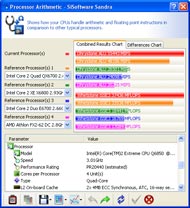Intel Core 2 Extreme QX6850
Test Systems and SiSoft SANDRA

How we configured our test systems: When configuring our test systems for this article, we first entered their respective system BIOS and set each board to its "Optimized" or "High performance Defaults". We then saved the settings, re-entered the BIOS and set memory timings for DDR2-800 with 4,4,4,12 timings. The hard drives were then formatted, and Windows XP Professional (SP2) was installed. When the Windows installation was complete, we installed the drivers necessary for our components, and removed Windows Messenger from the system. Auto-Updating and System Restore were then disabled and we set up a 1024MB permanent page file on the same partition as the Windows installation. Lastly, we set Windows XP's Visual Effects to "best performance," installed all of our benchmarking software, defragged the hard drives, and ran all of the tests .
|
|
|
|
|
|
We began our testing with SiSoftware's SANDRA XI, the System ANalyzer, Diagnostic and Reporting Assistant. We ran six of the built-in subsystem tests that partially comprise the SANDRA XI suite with the Core 2 Extreme QX6850 ( CPU Arithmetic, Multimedia, Multi-Core Efficiency, Memory, Cache, and Memory Latency) . All of the scores reported below were taken with the processor running at its default clock speed of 3.0GHz.
Not surprisingly, the new Core 2 Extreme QX6850 smoked all reference scores from processors listed in SANDRA's database. The version of SANDRA XI we were running had a QX6700 as its fastest desktop chip, for reference, though a QX6800 would undoubtedly report higher bandwidth. Regardless, you can see that AMD's fastest single chip processor configuration can't even hold a candle to the QX6850 in either the processor Arithmetic or Multi-Media tests. An interesting reference point would perhaps be that the Core 2 Duo Extreme X6800 offers basically half the performance of the QX6850 quad-core in these tests, which stands to reason obviously, with half the number of CPU cores available.
 C2E QX6850 @ 3.0GHz Memory Bandwidth |
 C2E QX6850 @ 3.0GHz Cache and Memory |
 C2E QX6850 @ 3.0GHz Memory Latency |
In terms of memory bandwidth, SANDRA reports a nice boost from the chip's 1,333MHz FSB. The CPU and DDR2-800 memory combination drives about 6.4GB/sec of bandwidth.









